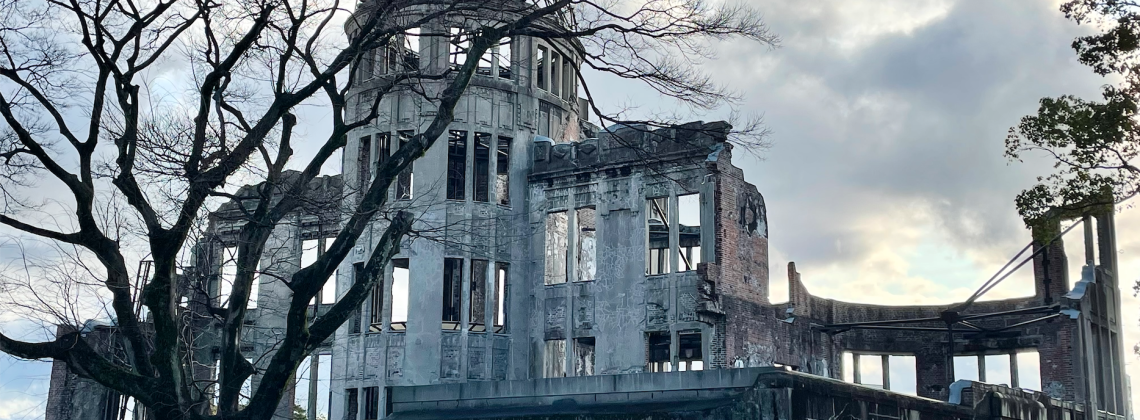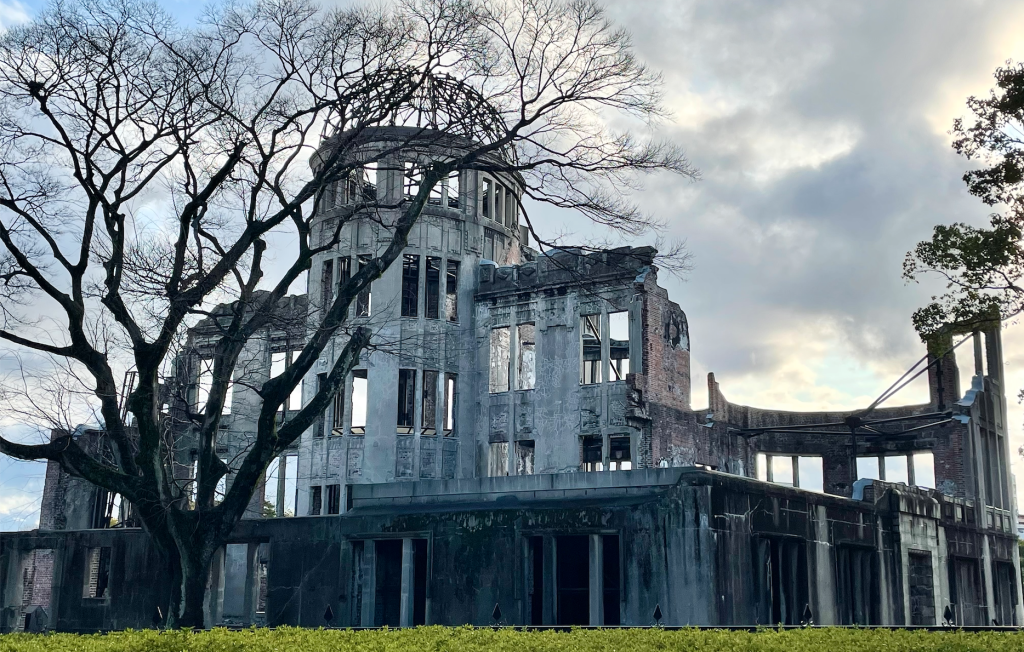

Renewed global order must fire our hearts and hopes
We took the bullet train to Hiroshima, 150 of the smoothest miles I’ve ever traveled to the most disquieting site I’ve ever seen.
Without quite knowing it, I had long been preparing for this journey, bearing with me a lifetime of images, arguments, lyrics; of anxiety, disbelief, dread. In A Place on Earth, Wendell Berry’s novel set in 1945, I’d read of Mat Feltner, who upon learning of the bomb “felt his mind borne, like a man in a little boat, on the crest of history, in a violence of pure effect . . .” I remembered Bono, still in his twenties, seized by “the unforgettable fire.” He glimpsed “Red wine that punctures the skin / Face to face / In a dry and waterless place.” I recalled historian Peter Bacon Hales’ claim that Hiroshima is the “firestorm” that haunts us all, “whose aftermath blows sickness, deformity, and death out into the landscape, enveloping the tidy suburbs and sowing poison on the farms, ranches, and wilderness spaces that ennoble the nation.”
That’s how we showed up in Hiroshima, and that’s how we left it: haunted. U2 (the very name signals threat) had felt it deeply and sang it true. “And if the mountains should crumble / Or disappear into the sea . . .” What else can Hiroshima leave you feeling? Crying?
Especially if you enter the museum. We moved with hundreds in a hush through darkened passageways, a cloud of witnesses to the atrocity below the cloud, a city scorched and caked with tortured bodies, with souls begging for rescue. “The instant I instinctively lowered my head, a strange flash of light engulfed my whole body,” reads one beautifully calligraphed testimony of August 6, 1945. “Their hair was scorched and frizzy,” remembered a photographer. “Their faces, arms, backs, legs—their whole bodies were badly burnt. Blisters had burst and sheets of burnt skin hung from them like rags. The scene through my viewfinder was blurred by tears that streamed down my cheeks. This was hell.”
In fact, the bomb destroyed order of the most profoundly human kind. Only torment could follow. A mother remembered the words with which her little girl had rushed off to school that morning: I’m off now. “That hurried farewell became our eternal parting,” the mother wrote, twenty-six years later. “Since that day, our home has been devoid of the warmth of family life.”
At age sixty-eight a survivor tried to sketch what he as an eleven-year-old experienced; he was at a school 1400 meters from the bomb’s hypocenter. Beneath his drawing he recorded these words: “Many of my friends lay as charred, blackened corpses, collapsed on top of one another. The scene was so devastating that I couldn’t distinguish between burnt wood and bodies that had turned to charcoal. The remains were identified as human because of the swarms of flies that rested on them.”
Hell.
Our visit was a few weeks ago now, and history keeps happening, day by unbelievable day. But I can’t imagine a better place to be as a supposed new world order is taking shape than standing there among the ashes of an old world order, ashes ground into memories and monuments and architecture and art, above all faces, faces of victims in photographs, faces of visitors peering back, wincing with loss.
In the war’s aftermath, eighty years ago, a just and necessary desperation seized the world, and with it the resolution that a new order, a truer order, was not simply possible but required—one that would ensure that the people of Hiroshima—and Nagasaki, and Berlin, and London, and hundreds more—would know not vulnerability but protection, not fracture but health. The very scars and stories that had driven their minds to horror also turned them to hope.
It was in the spirit of that hope that my wife and I had traveled to Hiroshima, along with two of our sons. One of them lives in Japan, and he guided us for dinner to a little restaurant on the edge of Peace Memorial Park. Seated, I could see over my left shoulder the “Atomic Bomb Dome,” what prior to August 6 had been the Hiroshima Prefectural Commercial Exhibition Hall, a magnificent edifice at the center of the city, completed in 1915. It was also at the center of the American attack: The bomb detonated 600 meters above it. Much of what surrounded the hall turned instantly to dust. But its main structures—including the structure of its great dome—had, unbelievably, survived, owing to the building’s central position in relation to the blast.
In the postwar years controversy surrounded the hall—or, rather, its ruins. Many pushed for demolition. Why keep tortured memories alive? Others had come to regard the domed building as a monument to hope, hope in the form of a warning, hope in the form of a witness: We are so fragile. But what we do can last—if we build well, if we place ourselves right where we need to be.
For pure symbolism, it’s hard to beat a dome. A dome crowns space and declares it sacred. It consecrates those who abide beneath. To set a dome in the sky is a dignifying act. And so we were drawn to this dome, a mighty exhibition indeed. “This has as much presence as any historical structure I’ve ever seen,” one of our sons said. We walked around and around the building, heads lifted, seeing the effects of fission on brick, taking in the rubble below. The blast had struck. The structure had held. Bodies floated in the river beside it, people screamed all around it, unspeakable terror changed the story of the race. But the structure remained.
Clearly it is not “strongmen” we need. Rather, it is strength we need, strength sustained by structures. In the devastating decades of the rising industrial, imperial order, after all, it was strongmen who led us toward Hiroshima. That Putin has threatened to crown his mounting atrocities with nuclear attack tells us everything we need to know: With everything we have, we must move in the other direction. If our own leaders fail to guide us there, how can we not turn against them? Should we fail to do so and instead take the way of the strongman, the imperial savagery that decades ago led to war will look genteel compared to what lies ahead. Hiroshima stands today to tell of a failed way. But also of another way.
We know this way, thanks to the courage and vision of truly strong men and women. One of them was killed, in another merciless act of strongman savagery, on this very day: April 4, 1968, fifty-seven years ago—he who U2 lauded in an era-shaping anthem on The Unforgettable Fire. A little more than three years before his murder, Martin Luther King, Jr., in his Nobel Peace Prize acceptance speech in Oslo, uttered a fundamental truth: “Civilization and violence are antithetical concepts.” “Sooner or later,” he warned, “all the people of the world will have to discover a way to live together in peace, and thereby transform this pending cosmic elegy into a creative psalm of brotherhood.”
We heard this psalm in Hiroshima that evening, in that little restaurant nestled in the shadow of the dome. To our left sat a young couple, laughing and talking, aware of nothing but each other, alive to the promise of goodness. At the table to our right sat a half-dozen fans of the local soccer team, their jerseys scribbled with autographs, their fun filling the room. We were all eating the specialty of the house, what our son was intent on making sure we didn’t leave the city without trying: Hiroshima’s renowned version of okonomiyaki, a fritter-like pancake whose savory scent warmed the space and sated our hunger. One translation of its name is simply your favorite dish.
Isn’t this what we long for? Places where we can sit together as friends, as family, and enjoy what we love with those we love? It was a brotherhood that night, the awesome historic terror of that space a memory, joy out in front instead.
“I refuse to accept the cynical notion that nation after nation must spiral down a militaristic stairway into the hell of thermonuclear destruction,” King, in the name of peace, declared that day in Oslo. And so for three more years he continued to build, to foster communities that give justice and love a place. He knew what was at stake. You don’t have to travel to Hiroshima to find out.
Eric Miller is Professor of History and the Humanities at Geneva College, where he directs the honors program. His books include Hope in a Scattering Time: A Life of Christopher Lasch, and Brazilian Evangelicalism in the Twenty-First Century: An Inside and Outside Look (co-edited with Ronald J. Morgan). He is the Editor of Current.
Image credit: the author